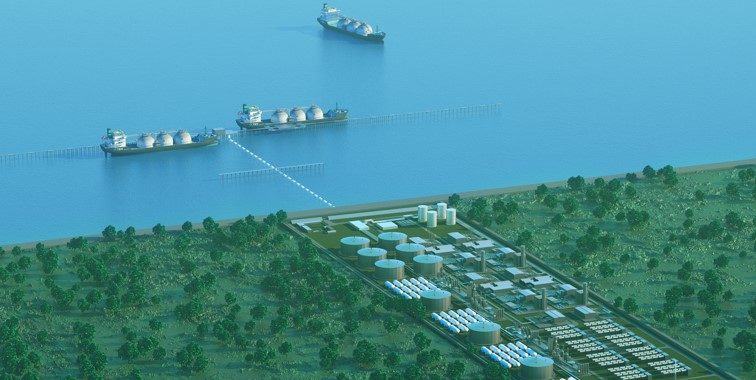Tree Energy Solutions (TES) and German energy company EWE have agreed to build an electrolyzer at the TES Green Energy Hub in Wilhelmshaven, Germany. The electrolyzer will have an output of 500 MW and will be operational by 2028, as part of plans to reach 1 GW of green hydrogen capacity at the site. “The declaration of intent is part of the German energy strategy to extract clean energy from the North Sea and expand the supply for hydrogen production,” the two companies said in a joint statement, noting that up to 2 GW of electrolyzers could be set up at the site to produce green hydrogen.
Rice University researchers have engineered a light-activated nanomaterial to convert ammonia into hydrogen. The scalable copper-iron catalyst, which uses inexpensive raw materials, needs only the power of light to break ammonia into hydrogen gas and nitrogen gas. The findings show that photocatalysis can be efficiently performed with inexpensive LED photon sources. The best thermocatalysts are made from platinum and related precious metals like palladium, rhodium, and ruthenium. “When illuminated with light-emitting diodes rather than lasers, the photocatalytic efficiencies remain comparable, even when the scale of reaction increases by nearly three orders of magnitude,” the researchers said in “Earth-abundant photocatalyst for H2 generation from NH3 with light-emitting diode illumination,” which was recently published in Science.
Schulich School of Engineering researchers at the University of Calgary in Canada have presented a new way to structure catalysts for fuel cells. They used a larger catalyst support – a 130-nanometer carbon particle, rather than a 30-nanometer one. They also changed the surface chemistry of the catalyst support by using platinum (Pt) and distributing nitrogen-functional surface groups uniformly. “We introduce a bottom-up designed spherical carbon support with intrinsic nitrogen-doping that permits uniform dispersion of Pt catalyst, which reproducibly exhibits high ORR mass activity of 638 ± 68 mA mgPt−1 at 0.9 V and 100% relative humidity (RH) in a membrane electrode assembly,” the researchers wrote in “Designing fuel cell catalyst support for superior catalytic activity and low mass-transport resistance,” which was recently published in Nature Communications.
McKinsey & Company said that total hydrogen demand could reach 600 million to 660 million tons by 2050 if four key conditions are met. The industry must scale up competitive supplies, stimulate local demand, facilitate cooperation across value chains, and develop transportation tech focusing on liquid hydrogen or ammonia. “Converting hydrogen to ammonia for transport to Europe from the Middle East then converting it back into hydrogen could result in an additional cost of $2.50 to $3 per kilogram of hydrogen in 2030, which is significant, given that green hydrogen production costs could be less than $2.00 per kg by 2030 in the region,” said the management consulting firm.
The US Department of Energy‘s (DoE) Oak Ridge National Laboratory and Argonne National Laboratory have kicked off a four-year project to power the next generation of trains with up to 100% hydrogen and other low-carbon fuels. The researchers installed Wabtec’s single-cylinder dual-fuel locomotive engine in the National Transportation Research Center, a DoE-designated user facility located at Oak Ridge. “The team will develop hardware and control strategies for the engine, which will run on hydrogen and diesel fuel to demonstrate the viability of using alternative fuels,” said Oak Ridge. Researchers said the project could accelerate the commercialization of these technologies to retrofit locomotives.
Popular content
Mitsubishi Heavy Industries and the Electricity Generating Authority of Thailand have signed an agreement to study and exchange information about hydrogen and carbon capture, utilization, and storage in Thailand. The collaboration will run for the next three years.
ACWA Power has signed a memorandum of understanding with PT Perusahaan Listrik Negara (PLN) to collaborate on hydrogen development in Indonesia. The two sides will develop 4 GW of battery storage capacity for renewable energy facilities and hydroelectricity-powered hydrogen developments in Indonesia, said the Saudi developer.
Airbus is developing cryogenic hydrogen storage tanks to use hydrogen in Nantes, France – where a team built the first cryogenic hydrogen tank ever produced at Airbus in about a year – and Bremen, Germany. “The final objective is to have a tank ready to install in the A380 demonstrator by 2026-28,” said Airbus.
*The text has been amended on Jan. 5 to reflect that the company partnering with TES in the development of an electrolyzer in Germany is called EWE and not RWE as we previously reported.
This content is protected by copyright and may not be reused. If you want to cooperate with us and would like to reuse some of our content, please contact: editors@pv-magazine.com.


2 comments
By submitting this form you agree to pv magazine using your data for the purposes of publishing your comment.
Your personal data will only be disclosed or otherwise transmitted to third parties for the purposes of spam filtering or if this is necessary for technical maintenance of the website. Any other transfer to third parties will not take place unless this is justified on the basis of applicable data protection regulations or if pv magazine is legally obliged to do so.
You may revoke this consent at any time with effect for the future, in which case your personal data will be deleted immediately. Otherwise, your data will be deleted if pv magazine has processed your request or the purpose of data storage is fulfilled.
Further information on data privacy can be found in our Data Protection Policy.